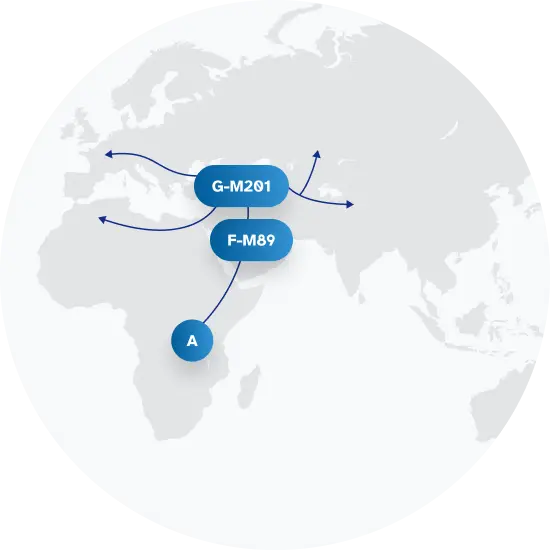Explore the Family Name Bailey
How common is the last name Bailey in the United States?
Based on the Decennial U.S. Census data, the popularity of the surname Bailey has slightly declined over a decade. In 2000, Bailey was ranked as the 66th most common surname in the U.S., but by 2010, it had dropped to the 72nd position, indicating a decrease of 9.09%. Despite this drop in ranking, the actual number of people with the Bailey surname increased from 265,916 in 2000 to 277,845 in 2010, a growth of 4.49%. However, the proportion of people with the surname Bailey per 100,000 decreased by 4.44% over this period.
| 2000 | 2010 | Change | |
|---|---|---|---|
| Rank | #66 | #72 | -9.09% |
| Count | 265,916 | 277,845 | 4.49% |
| Proportion per 100k | 98.57 | 94.19 | -4.44% |
Race and Ethnicity of people with the last name Bailey
The ethnic identity associated with the surname Bailey also saw some shifts between 2000 and 2010 according to the Decennial U.S. Census data. The largest ethnic group remained White, although its share decreased from 74.77% in 2000 to 72.45% in 2010. Meanwhile, the Black community saw an increase in the use of the surname Bailey, moving from 21.14% to 22.00%. Notably, the Hispanic population with the Bailey surname showed the highest percentage increase at 57.24%, going from 1.45% in 2000 to 2.28% in 2010. The Asian/Pacific Islander group and those identifying with two or more races also saw increases in their shares of the Bailey surname, while the American Indian and Alaskan Native group saw a small increase.
| 2000 | 2010 | Change | |
|---|---|---|---|
| White | 74.77% | 72.45% | -3.1% |
| Black | 21.14% | 22% | 4.07% |
| Hispanic | 1.45% | 2.28% | 57.24% |
| Two or More Races | 1.63% | 2.16% | 32.52% |
| American Indian and Alaskan Native | 0.61% | 0.62% | 1.64% |
| Asian/Pacific Islander | 0.4% | 0.5% | 25% |
Bailey ancestry composition
23andMe computes an ancestry breakdown for each customer. People may have ancestry from just one population or they may have ancestry from several populations. The most commonly-observed ancestry found in people with the surname Bailey is British & Irish, which comprises 53.5% of all ancestry found in people with the surname. The next two most common ancestries are French & German (22.8%) and Nigerian (3.4%). Additional ancestries include Eastern European, Scandinavian, Italian, Spanish & Portuguese, and Ghanaian, Liberian & Sierra Leonean.
Ready to learn more about your ancestry? Get the most comprehensive ancestry breakdown on the market by taking our DNA test. Shop 23andMe
| ANCESTRY BREAKDOWN | COMPOSITION |
|---|---|
| British & Irish | 53.5% |
| French & German | 22.8% |
| Nigerian | 3.4% |
| Other | 20.3% |

Possible origins of the surname Bailey
Your DNA provides clues about where your recent ancestors may have lived. Having many distant relatives in the same location suggests that you may all share common ancestry there. Locations with many distant relatives can also be places where people have migrated recently, such as large cities. If a large number of individuals who share your surname have distant relatives in a specific area, it could indicate a connection between your surname and that location, stemming from either recent ancestral ties or migration.
Based on 23andMe data, people with last name Bailey have recent ancestry locations in the United Kingdom of Great Britain and Northern Ireland and Ireland.
| RECENT ANCESTRY Location | Percentage |
|---|---|
| Greater London, United Kingdom | 85.30% |
| Greater Manchester, United Kingdom | 85.20% |
| Glasgow City, United Kingdom | 85.10% |
| Merseyside, United Kingdom | 85.00% |
| West Midlands, United Kingdom | 84.60% |
What Bailey haplogroups can tell you
Haplogroups are genetic population groups that share a common ancestor on either your paternal or maternal line. These paternal and maternal haplogroups shed light on your genetic ancestry and help tell the story of your family.
The top paternal haplogroup of people with the surname Bailey is G-L42, which is predominantly found among people with European ancestry. Haplogroup G-L42 is descended from haplogroup G-M201. Other common haplogroups include R-P311 and R-CTS241, which are predominantly found among people with European and European ancestry. Other surnames with similar common haplogroups are: Green, Brown, Smith, Wilson, Hill, Taylor, White, Cooper, Young, Johnson.
The most common maternal haplogroups of people with Bailey surname are: H1, T2b, H. These most commonly trace back to individuals of European ancestry.
 Paternal Haplogroup Origins G-M201
Paternal Haplogroup Origins G-M201
Your paternal lineage may be linked to Ötzi the Iceman
Ötzi the Iceman was discovered in 1991, protruding from a snow-bank high in the Alps near the Austrian-Italian border. His 5,300-year-old remains turned out to be so well preserved that researchers were able to construct a detailed account of his life and death. Chemical analysis of Ötzi's teeth indicates he came from the Italian side of the Alps. He had suffered during the year before his death with whipworm, a stomach parasite that was found in his digestive tract. Yet he was fit enough to climb 6,500 feet in elevation during the day or two before he met his end in a rocky alpine hollow. Ötzi apparently was murdered, struck by a stone arrow point that was found lodged in his left shoulder. The twisted position of his body indicates that the murderer, or one of his accomplices, pulled the arrow's shaft out of Ötzi's prone body.Yet whoever killed Ötzi did not take the valuable and finely wrought copper axe that he carried with him — an indicator that at the age of 45, the Ice Man may have been a figure of some importance in his community. Recently, scientists who were able to extract DNA from Ötzi's remains discovered that he belonged to a paternal lineage that stems from haplogroup G-M201. Today, Ötzi's lineage reaches its highest levels in Sardinia and Corsica, and was once common among early European farmers.
Your maternal lineage may be linked to Marie Antoinette
Because it is so dominant in the general European population, haplogroup H also appears quite frequently in the continent's royal houses. Marie Antoinette, an Austrian Hapsburg who married into the French royal family, inherited the haplogroup from her maternal ancestors. So did Prince Philip, Duke of Edinburgh, whose recorded genealogy traces his female line to Bavaria. Scientists also discovered that famed 16th century astronomer Nicolaus Copernicus traced his maternal lineages to haplogroup H.

What do people with the surname Bailey have in common?
Spoiler alert: it's complicated. People with the same last name are usually no more genetically similar than a randomly sampled group of people from the same population. That said, people with the same surname are more likely to have similar ancestries than randomly sampled individuals. The reason is the tendency of people with similar cultural or geographical backgrounds to preferentially mate with one another. That's why people who share a surname may be more likely to share traits and tendencies in common than people within the general population. Check out the percentages below to see the prevalences of tastes, habits, and traits of people with your surname compared with prevalences among 23andMe users.
Preferences
Traits
Habits
Wellness
Are health conditions linked to the last name Bailey?
The short answer is that, if there is an association between surname and health, it's usually more about your ancestry than your name. Individuals with a given surname are no more genetically similar than the general population but often have similar ancestries. The populations of people associated with those shared ancestries often have sets of genetic variations, also known as alleles, in common. Some of those alleles are associated with a greater likelihood of developing certain diseases.
Disease variant frequency by ancestry
Disease allele frequencies in populations associated with the surname Bailey are shown below. Important Note: not everyone with a disease allele will develop these health condition






























